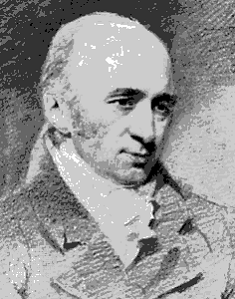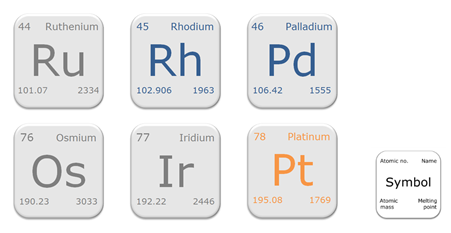


 Rhodium (Greek rhodon meaning "rose") was discovered in 1803 by William Hyde Wollaston,[i] soon after his discovery of palladium.[ii] [iii] [iv]
Rhodium (Greek rhodon meaning "rose") was discovered in 1803 by William Hyde Wollaston,[i] soon after his discovery of palladium.[ii] [iii] [iv]
He used crude platinum ore presumably obtained from South America.[v]
Wollaston was first alerted to the possibility of a new element by Hippolyte-Victor Collet-Descotils, who believed that the red colour of some platinum salts was actually caused by the presence of an unidentified metal.xi
 Wollaston conducted a series of chemical reactions on this liquid before producing a deep red powder, sodium rhodium chloride Na3[RhCl6]•nH2O, which gave a black, flaky precipitate of rhodium when treated with zinc.[vi] The liquid which remained had properties which matched no known substance.[vii]
Wollaston conducted a series of chemical reactions on this liquid before producing a deep red powder, sodium rhodium chloride Na3[RhCl6]•nH2O, which gave a black, flaky precipitate of rhodium when treated with zinc.[vi] The liquid which remained had properties which matched no known substance.[vii]
Wollaston collaborated with Smithson Tennant in a commercial venture, part of which was to produce pure platinum for sale. The first step in the process was to dissolve ordinary platinum in aqua regia (nitric acid + hydrochloric acid). Not all of it went into solution and it left behind a black residue. (Tennant investigated this residue and from it he eventually isolated osmium and iridium.) Wollaston concentrated on the solution of dissolved platinum which also contained [rhodium and] palladium. After the residues were washed with ethanol, the rose-red precipitate was reacted with zinc, which displaced the rhodium in the ionic compound and thereby released the rhodium as free metal.[viii]
[i] Wollaston, W. H. (1804). "On a New Metal, Found in Crude Platina". Philosophical Transactions of the Royal Society of London 94: 419–430. doi:10.1098/rstl.1804.0019.
[ii] Griffith, W. P. (2003). "Rhodium and Palladium – Events Surrounding Its Discovery". Platinum Metals Review 47 (4): 175–183.
[iii] Wollaston, W. H. (1805). "On the Discovery of Palladium; With Observations on Other Substances Found with Platina". Philosophical Transactions of the Royal Society of London 95: 316–330. doi:10.1098/rstl.1805.0024.
[iv] Usselman, Melvyn (1978). "The Wollaston/Chenevix controversy over the elemental nature of palladium: A curious episode in the history of chemistry". Annals of Science 35 (6): 551–579. doi:10.1080/00033797800200431..
[v] Lide, David R. (2004). CRC handbook of chemistry and physics: a ready-reference book of chemical and physical data. Boca Raton: CRC Press. pp. 4–26. ISBN 0-8493-0485-7.
[vi] J.W. Mellor, A Comprehensive Treatise on Inorganic and Theoretical Chemistry Volume XV, 1936, Longmans, Green and Co., p 546.
[vii] William Nicolson, A Journal of Natural Philosophy, Chemistry and the Arts, Volumes 9-10, 1804, W. Stratford, p 34-35.
[viii] Griffith, W. P. (2003). "Bicentenary of Four Platinum Group Metals: Osmium and iridium – events surrounding their discoveries". Platinum Metals Review 47 (4): 175–183.